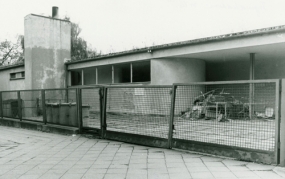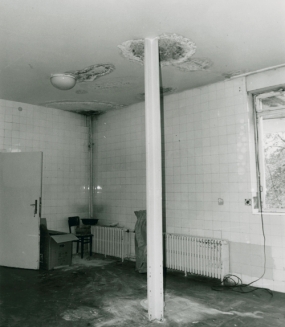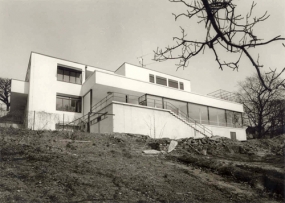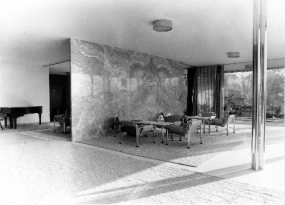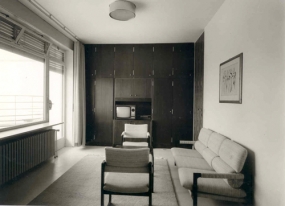The first final overall renovation of the Villa took place over the years 1981-1985. The project was prepared by the State Institute for Reconstruction of Historical Towns and Buildings in Brno. The designing team (Ing. arch. Jarmila Kutějová, Ing. Josef Janeček, Ing. arch. Adéla Jeřábková) was led by Ing. arch. Kamil Fuchs, CSc. (1930–1995), son of the renowned Brno architect Bohuslav Fuchs. The investor, the department of internal affairs of the National Committee of the City of Brno, established clear guidelines: the house should serve for advertising the city and occasional accommodation of guests. The public was clearly not taken into account. There was no construction-historical, restoration or other research carried out. The only sources of information made use of by the architects were the archive plans and photography from the collections of the Brno City Museum. The main ambition of the project was to restore the Villa to a solid construction-technical state and preserve it for future years. The work of the design team and the actual realization need to be clearly differentiated. The investor carried out minor construction work on the Villa, even prior to receiving the design preparation, wherein certain original elements were destroyed. The project was literally strictly vetoed quite often during the actual construction work with demands for alternative designs. The main supplier of the construction project, the Construction Company of the City of Brno, was also problematic in terms of their participation.
There were no actual statics defects to the house apart from the terrace with the stairway down to the garden which had not been sufficiently supported during the initial construction of the Villa. The subtle steel construction of the glazed panels in the main living area, as well as the steel frames of windows and doors on the bedroom floor, showed evidence of considerable levels of corrosion caused by large thermal bridges and condensation. They were only thoroughly cleaned, however, repaired and coated with a readily available paint. Supplies of large-surface glass from a foreign investor were rejected and the glazing was consequently carried out with two pieces with a central dividing joint sealed with transparent silicon putty. The only preserved window opposite the onyx inner wall had to be destroyed at the order of the investor in the final phase of the construction work as its colour and absence of a dividing joint was not “in line” with the new glazing. The original linoleum mark DLW was replaced by the domestic PVC. The curved inner wall from Macassar ebony near the dining room was secured with a shorter height dimension with this difference, against the will of the designers, dealt with by an adaptation with a high socle with inappropriate longitudinal veneer work. The preserved sanitary objects in the bathrooms and WC as well as the radiators had been to a great extent disassembled prior to the beginning of the design work by the construction crew of the investor who was unwilling to even discuss leaving them in situ or storing them. The original supporting construction for the retractable windows was preserved in both engine rooms while the disassembled drive units were newly supplemented. The engine room for the air technology was practically in its original state with only elements added which were needed for the functioning of the system. The original boiler room for coke was transformed into a calorifier room connected up to the outdoor caliduct. The upper dwelling terrace was newly paved with replicas of the paving stones created from the same sizes of stone, placed into exact forms and laid in accordance with the original installation drawing. The travertine socles and capitals of the railings of the upper terrace were original as were the constructions of the benches. The partially authentic fencing was supplemented to while the newly introduced roof had bitumen roofing. The damaged sections of outdoor plastering were replaced in the original structure with a white façade coat of a silicate base, while the internal plaster was sensitively repaired and treated with a layer of white paint.
A team of specialists under the supervision of Karel Ksander carried out construction historical research on the structure in the year 2001. Professor Ivo Hammer, the husband of the youngest daughter of the commissioners of the Villa, Professor Daniela Hammer-Tugendhat, supervised restoration research here over the years 2003-2005. This research along with careful studying of the documentation from the years 1981-1982 has indicated that the project was on a particularly high professional level for its day. The actual realization consequently occurred in line with the financial, technical, material and technological possibilities of the time period.
